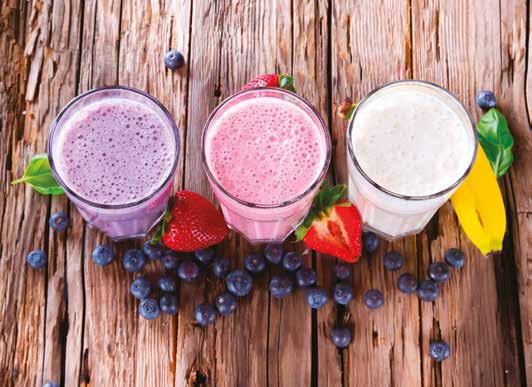Our nutrition expert Sophie Bruno explains the good and the bad when it comes to smoothie nutrition. During the Covid lockdown many people used the opportunity to make their own smoothies.
Fruit juices and smoothies are all the rage: supermarkets are brimming with them, kitchens are stocked up with high-tech fruit blending gadgets and high-street vendors have picked up on this hype – it is smoothie galore! It’s not hard to see why this particular sector is so popular; after all, it’s a quick, tasty and convenient way to get a shot of essential vitamins and minerals, which will contribute to meeting your daily nutritional requirements. This is certainly a very appealing aspect in our health-conscious, fast-paced lifestyle.
However, is fruit juice really as healthy as the marketing would lead us to believe? As with any dietary trend, it is important to look beyond what is often marketing hype to determine whether these products are really healthful.
Scientific overview of smoothie nutrition
Squeezed from whole fruit, 100% fruit juices often have no added sugars, are free from preservatives and flavourings, which make them very popular. Although fruit juices contain many vitamins and minerals naturally found in fruit, these beverages are no substitute for the real deal. Why is this? Whole fruits contain seeds and peel which are high in fibre, making them more nutrient-rich. Also, the fibre in whole fruit ensures that the natural sugars are absorbed more slowly into the bloodstream, creating the feeling of fullness and aiding digestion.
Fruit juices are often demonized in the media for being high in sugar. This is true, as several pieces of whole fruit will be required to produce a decent sized serving of fruit juice. When drinking fruit juice you will be getting a more concentrated level of natural fruit sugars and energy compared to consuming only one piece of fruit. This makes it very easy to over-consume fruit juices and smoothies and to drink more than one serving at a time.
Damage to teeth is another downside of excessive consumption of fruit juices; the free acids and sugars are released in the blending or juicing process from inside the fruit structure and are consequently able to come into direct contact with the teeth.
You will often find indicated on the labels of fruit juices the terms ‘concentrate’ or ‘not from concentrate’. This often puzzles consumers as they wrongly believe that fruit juice labelled ‘from concentrate’ is less healthy due to the associated connotations that it is less pure. However, this terminology merely relates to the processing technique in fruit juice production. In fact, there is be no difference whatsoever in the nutritional value between the two products. Both ‘from concentrate’ and ‘not from concentrate’ juices are pasteurized to remove potential pathogens that may have been in the fruit.
Commercial juices labelled ‘not from concentrate’ are made by juicing the fruit and then pasteurizing it. ‘From concentrate’ juice is juiced from the fruit, and then filtered through a processor that extracts water. This way, the juice takes up less space when transported. Before being packaged and sold, water is added back into the concentrated juice and then it is pasteurized.







